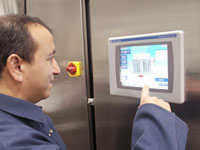
Food preparation start-ups can be a complex undertaking, particularly when you produce a variety of specialty items -- ranging from twice-baked potatoes to stuffed jalapeno appetizers.
But if you’re designing your fifth operation -- like Jay Arend -- chances are you know the ropes. Arend is the president and founder of Intevation Food Group, a new Plover, Wis. business supplying frozen appetizers, entrees and more to private label customers.
For most of his career, Arend has specialized in baked potato products.In this instance, however, Arend knew that a broader product line meant baking a wider variety of foods ... and possibly much more oven space filling up a plant floor.
Thus, Arend says he looked at spiral ovens, which are designed to occupy a much smaller footprint than more traditional linear models. At the same time, suppliers say spiral ovens are highly efficient, enabling high-capacity model users to cook up to 10,000 lbs. of finished products per hour.
Arend says his most previous plant experience involved a converted linear bakery oven that was 65 feet long.
"By the time you put an entrance into it and an exit out of it, you pretty easily eat up 100 feet of room space," he says.
After considering the problem, Arend turned to Unitherm Food Systems, Bristow, Okla. Deacon Turner is partner at Unitherm.
“The spiral oven is much more efficient and a lot smaller than a conventional linear oven,” Turner notes. “Our popular 8-foot (cube) mini-spiral oven has a 150-foot belt, and it is equivalent of a 40-foot long oven. A 16-foot spiral oven -- such as the one we delivered to Intevation -- saves an enormous amount of floor space and can replace several linear ovens.”
Cooking at temperatures up to 500 degrees (F), spiral ovens are rated at up to four times the efficiency of thermal oil ovens cooking the same product, Turner adds. A spiral oven uses a high-velocity fan to force the flow down through the oven in a uniform 360-degree pattern. Air flows evenly around all sides of the oven, and temperatures are consistent across the full width of each conveyor tier, from top to bottom of the oven.
Arend says that to accommodate escalating production demands, his previous enterprise had to resort to placing more layers of potatoes in each basket as it was sent through the linear oven -- while “turning up the temperature higher and higher.”
“It served the purpose at the time,” explains Arend. “But it didn’t give us the quality of product we have now, or the controls we have now. It also wasn’t as energy efficient”
Furthermore, the linear oven also required that an employee add potatoes to the baskets by hand, before pushing each basket into the oven. At that point, the product moved through on a conveyor system, but it cost Intevation additional money for personnel – particularly as production demands increased.
With the spiral oven, potatoes are baked individually. After the potatoes are washed, graded, and inspected for quality, they feed automatically in and out of the oven.
“By putting a spiral oven into our facility, we’ve saved quite a bit of real estate, and yet have attained improved flexibility, capacity and throughput,” says Arend. “Five people run our entire operation now, when in the past it took about eight people.”
The control factor
“When we started looking around, we saw that Unitherm had equipment that appealed to us -- not only because of its capacity and flexibility, but also its controls,” Arend says. “The oven is designed so you can control the air and the cooking moisture required for a given recipe. Our spiral oven also provides a variable speed control, according to the chain length and timing. Also, the controls are simple. And there are a lot of other features that affected our choice.”
The spiral oven purchased by Intevation, a medium size in Unitherm’s product offering, is a 16-foot cube containing 350 feet of belt. Despite the small footprint, this high-capacity spiral oven enables Intevation to produce large quantities of various items in the same oven.
Breakthrough consistency
“Potatoes come in many sizes. They are not uniform products like hamburger patties or sausage links,” notes Arend.
He notes that his decision to purchase Unitherm's 16-foot cubic spiral oven was influenced by the supplier's willingness to customize the equipment to meet his specific cooking requirements.
Arend explains that variation in potato size was an issue and -- without oven adjustment -- size differences could result in considerable product waste due to under- or over-cooking.
“Although we have a pretty tight specification on the length of the potato, they usually vary in diameter,” says Arend. “So, we found out that we could get very specific in our baking based on the profile of the potato in relation to the specific gravity [relative density] and other factors.”
Arend says he appreciates how new developments in spiral technology allow him to "dial in" the right settings (as needed. Now he can speed up the cooking process, develop the right colors, handle browning of foods, and even cook products of inconsistent size and shape – in this case potatoes – with extraordinary consistency so as to reduce product loss.
“Unitherm had equipment that appealed to us, not only because of its capacity and flexibility, but also the controls,” Arend says. “The oven is designed so you can control the conditions required for any given recipe.”
Arend says he had many discussions with Unitherm to determine the appropriate recipe to cook potatoes with specific profiles.
“Now we can plug a recipe into the control panel and it adjusts variables such as time, temperature, airflow and humidity," he says. "Since we are just starting operations, we have tweaked these recipes a few times and now get very consistent results in our baking and we have also reduced our waste to less than one percent."
Unitherm's Turner believes Intevation is the first company to bake potatoes in a spiral oven.
“To my knowledge this has never been done to this extent in the industry,” he says.
Beyond potatoes, Intevation has plans to use the spiral oven to cook a dozen or more of its private-labeled specialty items, including stuffed jalapenos and other appetizers as well as entrees and full meals.
Notes Turner, “With this same unit and new settings through the controls, Intevation can also cook beef, pork, chicken, ham and seafood, plus a very wide variety of other foods.”
Arend says he is talking to Unitherm about a second, smaller spiral oven to satisfy a request for a new appetizer product for a national company.
“The anticipated volume is so great that it looks we will have to purchase a separate oven, since our existing oven is pretty much tied up with current production,” says Arend. “The nice thing is that now that we know about the spiral oven and what it can do, we won’t have to use a lot of production space to install another in our operation.” -- Unitherm Food Systems
(918) 367-0197 / www.unithermfoodsystems.com
